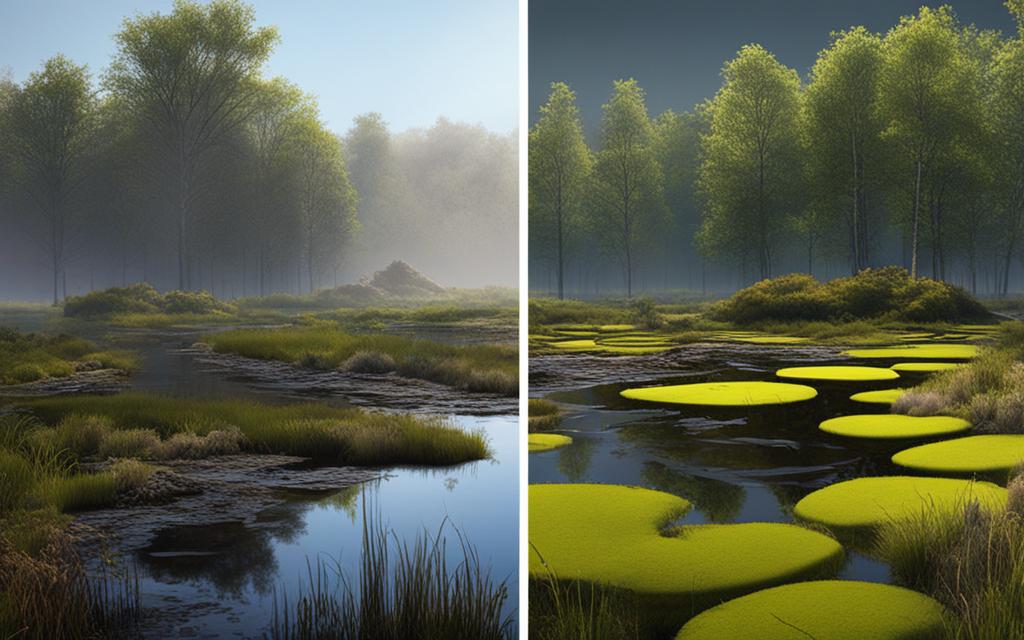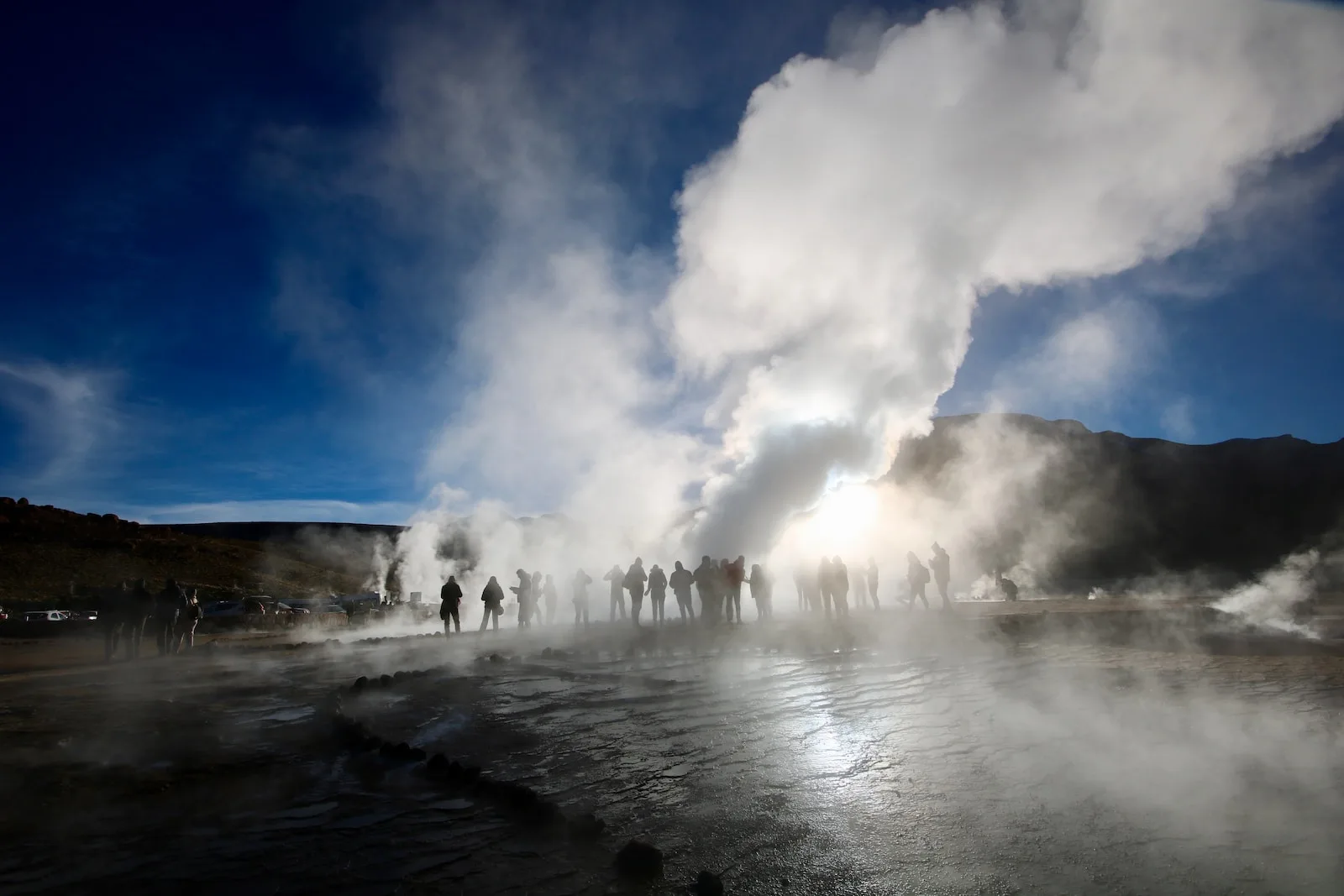Learn about the distinctions between bogs and fens, two intriguing wetland ecosystems that provide valuable insights into our geologic past.
Bogs and fens are home to a diverse range of plants and animals, including unique species such as bog lemings, pitcher plants, and sundews. While both ecosystems share similarities, they differ in terms of water sources, nutrient levels, and characteristics. Understanding these distinctions can help us appreciate the importance of wetland conservation and the preservation of these delicate ecosystems.
Key Takeaways:
- Bogs and fens are biologically fascinating wetland ecosystems.
- Bogs are typically rainwater-filled depressions, whereas fens receive groundwater.
- Bogs are nutrient-poor and acidic, while fens are mineral-rich and less acidic.
- Bogs feature characteristics such as acidic soil, low oxygen levels, and carnivorous plants.
- Fens exhibit mineral-rich conditions, diverse plant communities, and alkaline environments.
Bog Characteristics
Bogs are unique wetlands with specific characteristics that set them apart from other ecosystems. One of the defining features of bogs is their acidic soil, which creates challenging conditions for plant growth. The acidity of the soil is caused by the accumulation of organic matter, primarily from decaying plants, and the lack of mineral-rich nutrients. As a result, bogs are known for being nutrient-poor environments.
Sphagnum moss is a common plant found in bogs and plays a critical role in their ecosystem. This moss forms a thick layer that acts as a sponge, holding water and creating a low-oxygen environment. The slow decomposition of plant material in the waterlogged conditions leads to the accumulation of peat, a type of organic material that forms over thousands of years.
Bogs are also known for being home to unique plant species, including carnivorous plants. Adapted to the nutrient-poor conditions, carnivorous plants such as pitcher plants and sundews have developed specialized mechanisms to capture and digest insects. These fascinating plants have evolved to extract the necessary nutrients from their prey in order to survive in the harsh bog environment.
- Acidic soil
- Nutrient-poor
- Sphagnum moss
- Carnivorous plants
- Low oxygen levels
Bog Characteristics
| Characteristics | Description |
|---|---|
| Acidic soil | The soil in bogs is highly acidic due to the accumulation of organic matter and the absence of mineral-rich nutrients. |
| Nutrient-poor | Bogs have low nutrient levels, resulting in limited plant growth and supporting specialized flora adapted to these conditions. |
| Sphagnum moss | Sphagnum moss is prevalent in bogs and forms a thick layer that holds water and creates a low-oxygen environment, contributing to peat formation. |
| Carnivorous plants | Bogs are home to unique carnivorous plants such as pitcher plants and sundews, which have evolved to obtain nutrients from captured insects. |
| Low oxygen levels | The waterlogged conditions in bogs lead to low oxygen levels, creating a challenging environment for many organisms. |
Fen Characteristics
Fens are distinct wetland ecosystems with unique characteristics that set them apart from bogs. Unlike bogs, which are filled by rainwater, fens are fed by mineral-rich groundwater, resulting in a nutrient-rich environment.
Fens support diverse plant communities, including sedges, orchids, and other wetland-adapted species. These plants thrive in the alkaline conditions created by the high mineral content of the water. Fens are often found near lakes, rivers, and streams, benefiting from the constant flow of groundwater. This proximity to flowing water allows fens to maintain higher water levels compared to bogs.
As a result, fens provide a habitat for a wider range of wildlife. They are home to reptiles, amphibians, and small mammals that need the combination of both wet and dry conditions to survive. The diverse plant and animal life in fens contributes to their ecological importance and enhances overall wetland biodiversity.
To visually understand the differences between bogs and fens, refer to the table below:
| Characteristic | Bog | Fen |
|---|---|---|
| Water Source | Rainwater | Groundwater |
| Nutrient Levels | Nutrient-poor | Nutrient-rich |
| Acidity | Highly acidic | Alkaline |
| Plant Communities | Sphagnum moss, carnivorous plants | Sedges, orchids, wetland-adapted species |
| Wildlife | Specialized bog species | Reptiles, amphibians, small mammals |
As shown in the table, bogs and fens differ in water source, nutrient levels, acidity, plant communities, and wildlife. These variations contribute to the distinct ecological roles and importance of each wetland ecosystem.
Bog and Fen Formation
Bogs and fens, two distinct types of wetland ecosystems, have unique formation processes influenced by various factors. Understanding how these ecosystems develop is essential for gaining insights into their ecological significance. Both bog and fen formation can be traced back to glacial activity and subsequent hydrological changes. Precipitation and peat accumulation also play crucial roles in shaping these wetlands.
Glacial activity, such as the retreat of glaciers during the last ice age, created the initial conditions for the formation of bogs and fens. As the glaciers receded, they left behind shallow depressions that gradually filled with rainwater or groundwater, giving rise to these wetland ecosystems.
Precipitation is a vital factor in the formation of bogs. Bogs typically form in areas with high levels of rainfall, which leads to the accumulation of water in depressions. Over time, this water saturates the soil and creates anaerobic conditions, where oxygen availability is limited. The lack of oxygen combined with the presence of sphagnum moss, a natural sponge, promotes the slow decomposition of plant material, resulting in the accumulation of peat.
Hydrological changes also contribute to the formation of bogs and fens. As peat accumulates in these wetlands, it becomes tightly compressed and impermeable, effectively cutting off the bog or fen from the water table. This hydrological isolation further enhances the unique characteristics of these ecosystems, such as the acidic and nutrient-poor conditions found in bogs.
Comparing Bog and Fen Formation
| Factors | Bog Formation | Fen Formation |
|---|---|---|
| Water Source | Rainwater | Groundwater |
| Precipitation | High levels of rainfall | Varies; can be influenced by local hydrology |
| Peat Accumulation | Slow decomposition of plant material in low-oxygen environment | Generally lower peat accumulation compared to bogs |
| Hydrological Changes | Becomes hydrologically isolated, leading to acidic and nutrient-poor conditions | Varies; can be influenced by local hydrology |
Understanding the formation processes of bogs and fens provides valuable insights into their diverse characteristics and ecological functions. These wetland ecosystems are not only visually captivating but also serve as crucial habitats for a wide range of plant and animal species. Conservation efforts aimed at protecting bogs and fens are vital to preserve their unique features and promote the overall health and biodiversity of wetland ecosystems.
Conclusion
Bogs and fens are vital wetland ecosystems that deserve our attention and conservation efforts. These unique habitats provide a home for a diverse range of plant and animal species, many of which are found exclusively in these wetlands. By preserving bogs and fens, we protect the rich biodiversity they harbor.
Furthermore, bogs and fens play a crucial role in ecosystem preservation. These wetlands act as carbon sinks, storing significant amounts of carbon dioxide and mitigating climate change. Conserving these ecosystems is not only important for the survival of their inhabitants but also for the overall health of our planet.
Wetland conservation efforts should focus on preserving the delicate balance of nutrient levels and hydrological conditions that sustain bogs and fens. By maintaining the right conditions for these wetlands to thrive, we ensure the continued survival of the unique species that call them home and promote ecological stability.
In conclusion, the importance of bogs and fens cannot be overstated. These wetland ecosystems are not only fascinating remnants of our geologic past, but they also contribute significantly to biodiversity and act as crucial carbon sinks. By prioritizing wetland conservation, we can protect these fragile ecosystems and secure a sustainable future for generations to come.
FAQ
What is the difference between a bog and a fen?
Bogs are usually enclosed depressions filled by rainwater, while fens are fed by a steady source of groundwater.
What kind of plants and animals can be found in bogs and fens?
Both ecosystems are home to a variety of plants and animals, including unique species such as bog lemings, pitcher plants, and sundews.
How do bogs and fens differ in terms of nutrient levels?
Bogs are nutrient-poor and acidic, while fens are mineral-rich and less acidic.
What are the characteristics of a bog?
Bogs have acidic soil, nutrient-poor conditions, and are home to sphagnum moss and carnivorous plants.
How do fens differ from bogs?
Fens are fed by mineral-rich groundwater, have alkaline conditions, and support diverse plant communities.
How are bogs and fens formed?
Bogs form in enclosed depressions filled by rainwater, while fens are fed by groundwater. Glacial activity and peat accumulation are vital processes in their formation.
Why are bogs and fens important?
Bogs and fens play a crucial role in preserving biodiversity and storing carbon.
 Skip to main content
Skip to main content


